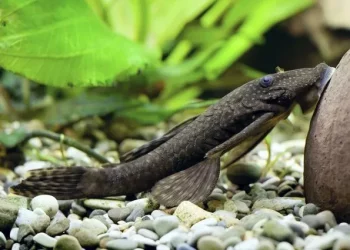The Australian lungfish, also known as the Queensland lungfish, is a unique and ancient freshwater fish found in eastern Australia. One of the most fascinating aspects of this species is its ability to breathe air and survive out of water for extended periods of time. In this article, we will explore the Australian lungfish’s ability to live out of water and the adaptations that allow it to do so.
Adaptations for Air Breathing
The Australian lungfish is an air-breathing fish, meaning it has the ability to breathe air through a primitive lung. This adaptation allows it to survive in stagnant or low-oxygenated water, as well as to survive droughts. The lungfish has a specialized structure called the suprabranchial chamber that allows it to breathe air directly. This chamber is located at the back of the throat and is connected to the lungfish’s respiratory system.
When the water levels in their habitat become too low or the water becomes too stagnant, the Australian lungfish can move to shallow areas and gulp air from the surface using its specialized chamber. The fish can also store air in its lung and use it to breathe while out of water.
Ability to Survive Out of Water
The Australian lungfish is unique in its ability to survive out of water for extended periods of time. During the dry season, when the water levels in their habitat become too low, the lungfish can aestivate, or enter a state of dormancy, until more favorable conditions return.
During aestivation, the lungfish burrows into the mud and secretes a mucus cocoon around itself to retain moisture. It then reduces its metabolic rate and enters a period of prolonged inactivity. This allows the fish to conserve energy and survive until more favorable conditions return.
Additionally, the Australian lungfish is capable of moving short distances overland using its fins to propel itself forward. This movement is slow and cumbersome, but it allows the fish to move to a new water source if necessary.
Conservation of the Australian Lungfish
The Australian lungfish is listed as a vulnerable species by the International Union for Conservation of Nature (IUCN) due to habitat loss and degradation, as well as overfishing. The species is protected under Australian law, and it is illegal to catch or harm them without a permit.
As the Australian lungfish is an important part of the freshwater ecosystem, it is crucial that steps are taken to protect its habitat and ensure its survival. This includes reducing pollution in waterways, conserving wetland habitats, and limiting the impact of human activity on the species.
In conclusion, the Australian lungfish is a unique and fascinating species that has evolved to survive in a variety of conditions. Its ability to breathe air and survive out of water for extended periods of time is just one of its many adaptations. As a vulnerable species, it is important that we take steps to protect its habitat and ensure its survival for future generations to enjoy.


























